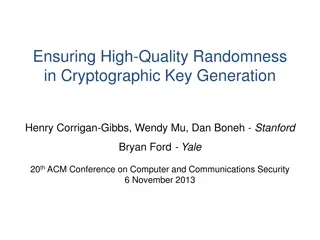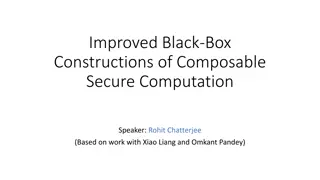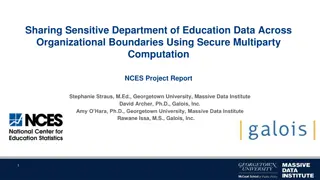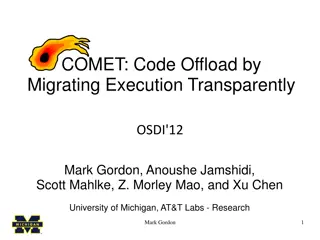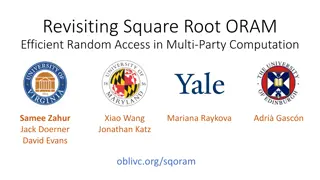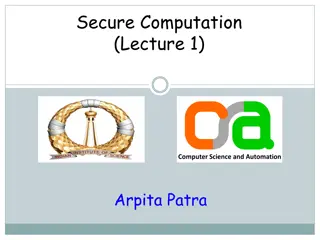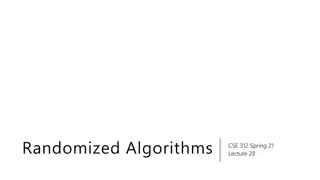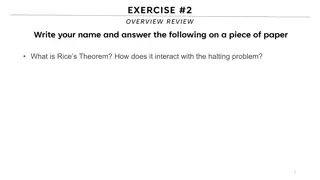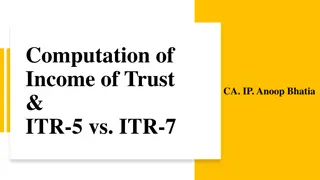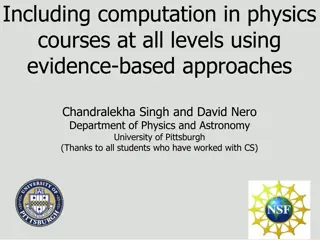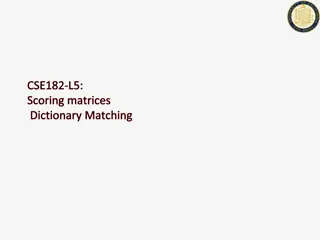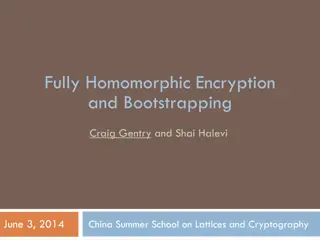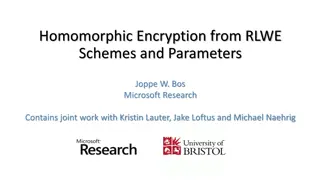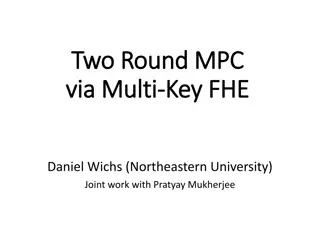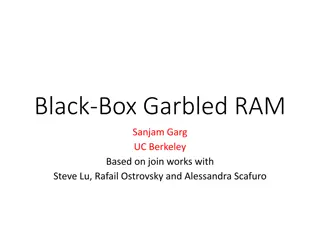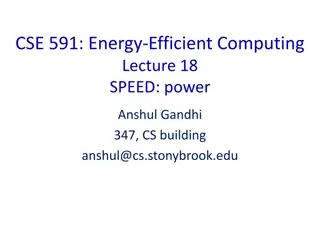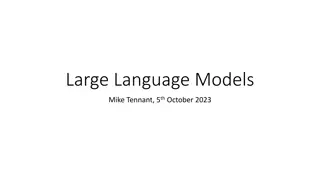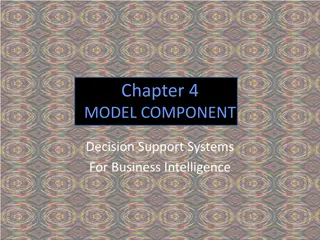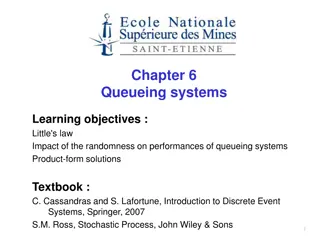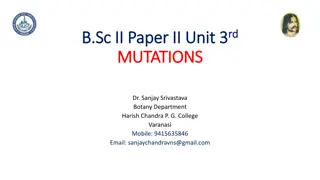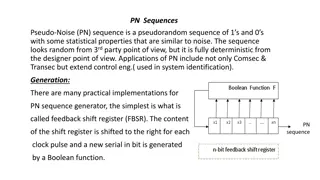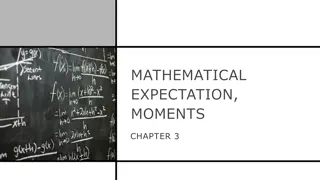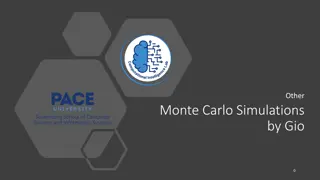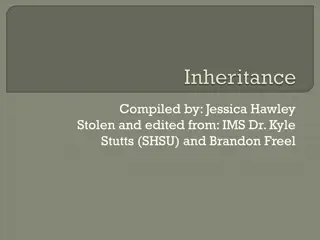The Power of Randomness in Computation
Explore the significance of randomness in various computational aspects including random sampling, cooking techniques, polling methods, investing strategies, and its role in computer science. It delves into randomized algorithms, Monte Carlo simulations, cryptography, and more.
Download Presentation

Please find below an Image/Link to download the presentation.
The content on the website is provided AS IS for your information and personal use only. It may not be sold, licensed, or shared on other websites without obtaining consent from the author. Download presentation by click this link. If you encounter any issues during the download, it is possible that the publisher has removed the file from their server.
E N D
Presentation Transcript
The Power of Randomness in Computation David Zuckerman University of Texas at Austin
Random Sampling: Flipping a Coin Flip a fair coin 1000 times. # heads is 500 35, with 95% certainty. n coins gives n/2 n. Converges to fraction 1/2 quickly.
Cooking Saut ing onion: Expect half time on each side. Random saut ing works well.
Polling Do you favor legalizing gay marriage? Gallup Poll, May 5-8 Margin of error = 4% 95% confidence Sample size = 1,018 2% 45% 53% Huge population Sample size independent of population Yes No Unsure
Investing Assume stock prices follow random walk. Best to diversify: own many stocks. Achieve same average return while reducing risk.
Random Sampling in CS Area of region Pick many random points in square. Compute fraction r that lie in region. Area estimate = r .Area(square).
Outline Power of randomness: Randomized algorithms Monte Carlo simulations Cryptography (secure computation) Is randomness necessary? Pseudorandom generators Randomness extractors Conclusions/coding theory/miscellaneous
Basic Definitions Random bit X: Pr[X=0] = Pr[X = 1] = . Random integer Y in {1,2, ,100}. For all i, Pr[Y=i] = 1/100. Independent random bits X1X2 X100: For any i, conditioned on all Xjexcept Xi, still Xiis a random bit. Equivalently, Pr[X1 X100 = b1 b100] = 2-100.
Random Sampling in Computer Science Sophisticated random sampling used to approximate various quantities. Volume of a region Integral # solutions to an equation Load balancing
Another Use of Randomness: Equality Testing Does 122,000,001+7442=1431,000,001+197? Natural algorithm: multiply it out and add. Inefficient: need to store 2,000,000 digit numbers. Better way?
Another Use of Randomness: Equality Testing Does 122,000,001+7442=1431,000,001+197? No: even+odd odd+odd. What if both sides even (or both sides odd)? Odd/even: remainder mod 2.
Randomized Equality Testing Pick random number r of appropriate size (in example, < 100,000,000). Compute remainder mod r. Can do efficiently: only keep track of remainder mod r. Example: 73mod 47: 73=72 .7=49.7=2.7=14 mod 47.
Randomized Equality Testing If =, then remainder mod r is =. If , then remainder mod r is , with probability > .9. Can improve error probability by repeating: For example, start with error .1. Repeat 10 times. Error becomes 10-10=.0000000001.
Randomized Algorithms Examples: Randomized equality testing Primality testing Approximation algorithms Optimization algorithms Many more Often much faster and/or simpler than known deterministic counterparts.
Monte Carlo Simulations Many simulations done on computer: Economy Weather Molecular interactions Often have random components Can model actual randomness or complex phenomena.
Cryptography Amazon.com laptop user Alice and Bob have no shared secret key. Eavesdropper can hear (see) everything communicated. Is private communication possible? Proofs essential.
Security impossible (false proof) Eavesdropper has same information about Alice s messages as Bob. Whatever Bob can compute from Alice s messages, so can Eavesdropper.
Security possible! Flaw in proof: although Eavesdropper has same information, computation will take too long. Bob can compute decryption much faster. How can task be easier for Bob?
Key tool: 1-way function Easy to compute, hard to invert. Toy example: assume no computers, but large phone book. f(page #)=1st phone number on page. Given page #, easy to find 1st phone number. Given 1st phone number, hard to find page #.
Key tool: 1-way function Easy to compute, hard to invert. Example: multiplication of 2 primes easy. e.g. 97.127=12,319 Factoring much harder: e.g. given 12,319, find its factors. f(p,q) = p.q is a 1-way function.
Public Key Cryptography Bob chooses 2 large primes p,q randomly. Sets N=p.q. p,q secret N Enc(N,message) Fast decryption requires knowing p and q.
More Cryptography Authentication. Millionaire s problem: Who s richer? No other information revealed. Zero Knowledge: Alice to convince Bob she knows password. Without revealing password. Bob can catch Alice if she lies.
Power of Randomness Randomized algorithms Random sampling and approximation algorithms Randomized equality testing, primality testing Many others Monte Carlo simulations Cryptography
Randomness wonderful, but Computers typically don t have access to truly random numbers. Example: exact time of clock 2:54.9417 gives random number 417. But program may check clock in regular pattern. What to do?
Is Randomness Necessary? Essential for cryptography: if secret key not random, Eavesdropper could learn it. Unclear for algorithms. Example: perhaps a clever deterministic algorithm for equality testing. Major open question in field: does every efficient randomized algorithm have an efficient deterministic counterpart?
What is minimal randomness requirement? Can we eliminate randomness completely? If not: Can we minimize quantity of randomness? Can we minimize quality of randomness? What does this mean?
What is minimal randomness requirement? Can we eliminate randomness completely? If not: Can we minimize quantity of randomness? Pseudorandom generator Can we minimize quality of randomness? Randomness extractor
Pseudorandom Numbers Computers rely on pseudorandom generators: PRG 141592653589793238 71294 long random-enough string short random string What does random enough mean?
Classical Approach to PRGs PRG good if passes certain ad hoc tests. Example: frequency of each digit 1/10. But: 012345678901234567890123456789 Failures of PRGs reported: 95% confidence intervals ( ) ( ) ( ) PRG1 PRG2 PRG3
Pairwise Independence Every pair of random variables independent.
Pairwise Independence PRG maps k bits to 2k 1 bits. Very useful tool. But: fails in many situations E.g., Parity.
Modern Approach to PRGs [Blum-Micali, Yao] Require PRG to fool all efficient algorithms. random Alg same behavior pseudorandom Alg
Modern Approach to PRGs Hard functions give PRGs [Nisan-Wigderson] What if no assumption? Unsolved and very difficult: related to $1,000,000 NP = P? question. Can construct PRGs which fool restricted classes of algorithms, without assumptions.
Quality: Weakly Random Sources 0.01 What if only source of randomness is defective? Weakly random number between 1 and 1000: each has probability 1/100. Can t use weakly random sources directly. 0.009 0.008 0.007 weakly random almost random truly random 0.006 0.005 0.004 0.003 0.002 0.001 0 1 2 3 4 5 6 7 8
Goal very long long Ext weakly random almost random Problem: impossible.
Solution: Extractor [Nisan-Zuckerman] short truly random very long long Ext weakly random almost random
Power of Extractors Sometimes can eliminate true randomness by cycling over all possibilities. Many unexpected applications to variety of areas. Useful even when no weakly random source apparently present. Caveat: strong in theory but practical variants weaker.
Conclusions Randomness extremely useful in CS: Algorithms Monte Carlo simulations Cryptography. Don t need a lot of true randomness: Short truly random string: PRG. Long weakly random string: extractor.
Theoretical Computer Science Mathematical aspects of CS. Algorithms and complexity. Complexity includes study of and nontrivial connections among: Intractibility Pseudorandomness Cryptography Coding Theory
Error Correcting Codes Communication over a Noisy Channel: Adversary corrupts 10% of the bits. Problem: Recover the (entire) message. Solution: Introduce redundancy.
Error-Correcting Codes Deep-space communication Internet Cellphones Satellite Broadcast Audio CDs Bar-codes
Codes from Polynomials Encoding: Alice wants to send (a,b). Let L(x) = ax +b. Send L(1), L(2), , L(7).
Codes from Polynomials Adversary: Corrupts two values. Decoding: Find the (unique) line that passes through 5 points.
Math in Computer Science Probability Discrete mathematics Graph theory, combinatorics, logic Linear algebra Number theory Particularly for cryptography G.H. Hardy statement
A Professors Duties at a Research University Research Also, funding Teaching Organized classes Individualized instruction Service External: program committees, editorial boards Internal: various committees



